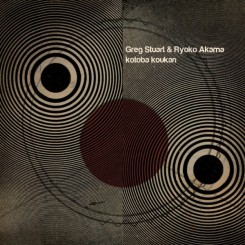kotoba koukan presents recordings of three of Ryoko Akama’s text-based scores and one composition by percussionist Greg Stuart. The duo built up these pieces painstakingly, exchanging files and ideas over the internet, and in the process creating finely detailed fields of sound that are shrouded in silence. Listening to the four pieces is like wandering into a village swamped in mist – you’re seemingly lost in the murk, then buildings loom up out of the haze with little warning, assuming a shape that seemed impossible only moments earlier. What was ethereal becomes corporeal.
Yet here, as on Akama’s previous wonderful solo release, Code of Silence, there is solidity here among the clouded, empty spaces. You can hear it on Stuart’s composition, border ballad, where the duo kick out the jams to lay down a scruffy collage of pebbly clonks, tinny hacks, metallic rattles and gassy hisses that bring to mind the more rambunctious electroacoustic manglings of VA AA LR or Seth Cooke. The border of the title is perhaps the boundary between noise and silence, although on this evidence it is somewhat of a porous one. No line in the sand, instead waves on the beach.
Akama has made the scores for her three pieces available to view on her website. The score for e.a.c.d shows various words and phrases arranged either side of a horizontal line (another border, perhaps? A path? Or an axis around which words and ideas can cluster?). While it’s clear that the line represents the duration of the piece, the relation of the specific words – which include ‘like a chimney’, ‘long’, ‘small, ‘big’ and so on – to the sounds produced is rather more elusive. The score itself is an enigmatic but visually compelling object and an interesting artefact in its own right (write?). The fact that the relationship between what we’re reading in the score and what we’re hearing isn’t always clear only adds to the sense of mystery.
The recorded version starts with the sounds of breath, possibly the regular inhalation and exhalation of the sleeper who has just dropped off. There’s an immediate sense of humanity, something often lacking in more austere reductionist works. A regular piano note sounds, like the chime of a city clock. Occasionally it feels as if we’re listening to radically magnified time, zooming into the moments of being between those chimes and amplifying the sounds of dust motes dancing in the rays of the morning sun. Throughout this, layers of abstract noise slide in and out of hearing. Crackles and electrical spittings. Wavering electronic tones, appearing and disappearing, carefully deployed but somehow seeming to occur naturally, as if they were clouds and rain in a weather system.
At just five minutes, _con.de.structuring explores a more curtailed sound world, but shares some of its predecessor’s aspect, in particular grainy ambient fuzz and austere electronic tones drifting across one another. A rather nice dull ringing crops up now and again, like a rusty old alarm clock who insists on doing its job even though it should have been retired to a box under the stairs years ago.
The score is rather fun, too. The scene setting is cheekily deadpan (‘for more than two performers’, ‘for five minutes without any clock or stopwatch’), and the score itself contains more enigmatic instructions, which bring some of the sounds we hear into a kind of structural focus:
“01 each performer predetermines three sounds that can be described as soundless
02 each performer plays three soundless sounds at least once in each minute. every sound should be played for ten seconds.
03 only one occasion, each sound should be played for thirty-seven seconds.
04 when five minutes are complete, stay quietly till all perfomers finish their parts.”
(Copyright Ryoko Akama 2014).
fadeinfadeout – intended for sine tones and percussions – is not dissimilar, and although at 25 minutes, the work is longer, its wintery sonic world is closest to that of its shorter companion. It’s the most incorporeal piece here – on early listens at least – with its slowly phasing sine tones and micro-percussion thrums seeming to etch parallel lines that gradually curve across an almost featureless plain. Those marks in sound are our only guides in a territory that seems both nowhere and nowhen.
If, at certain volumes, fadeinfadeout makes a virtue of its misty unobtrusiveness, with the headphones in and the volume up – or in a venue with the right sound system – a pronounced physicality comes to the fore. In fact, it’s almost monolithic, the mist clouds becoming huge icebergs, slowly floating through a freezing sea. A lower-register throb becomes a slow pulse and, about halfway through a new, higher pitched sine tone fades in, thrillingly piercing in its uncaring blast. If the gradual fade out into a more tranquil motorised gurgle of the final third is somewhat predictable – the clue’s in the title, after all – it is, nevertheless, a satisfying comedown.
+++
+++

1 Comment